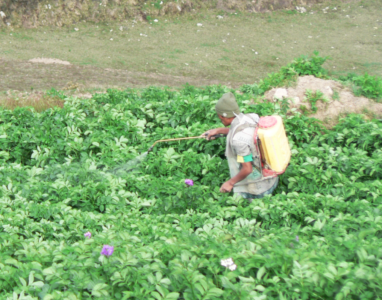
More than 170 years after it provoked the Great Famine of Ireland, late blight disease remains the biggest threat to potato farming globally, causing USD billions of crop loss each year. In most areas, farmers can only grow potatoes if they regularly apply fungicides, which control the highly destructive pathogen but pose risks to the environment and farmers, if applied without protective equipment.
Developing late-blight resistant potatoes has long been a priority for breeders, and hundreds of resistant varieties have been released in the past century. However, because of the pathogen’s ability to evolve ways to overcome the resistance of widely cultivated varieties, farmers still need to apply fungicides, and it is hard for them to know when and how much to apply.
“In some parts of the world, late blight may completely destroy farmers’ potato crops, threating their food security and incomes,” said International Potato Center (CIP) plant pathologist Willmer Perez.
Perez and colleagues have developed an easy-to-use decision support tool to help farmers optimize their fungicide use, in order to ensure good harvests while reducing production costs and health and environmental risks. The tool, which is customized for each country, uses information on the late blight-susceptibility levels of local varieties, the effectiveness of locally-available fungicides, and local weather data to provide farmers with advice on when to apply those agrochemicals.
Perez explained that small-scale farmers tend to apply more fungicides than needed, and more often than needed. He noted that in areas with high late-blight pressure, farmers may spray fungicides on their crop as many as 25 times during the four-month growing season, which represents a significant cost for resource-poor families. He added that many farmers also mix several fungicides together, increasing the health and environmental risks.
“In the majority of developing countries, farmers don’t use protective equipment, so there are high levels of intoxication and chronic health problems that appear after using these agrochemicals for 15 or 20 years,” Perez said.
After years of training potato farmers in approaches for decreasing fungicide use, Perez and colleagues designed a decision support tool that consists of sets of cardboard discs in concentric circles, which farmers align based on the variety they are growing, recent weather conditions and the last time they applied fungicides to determine when they should apply that agrochemical again.
After testing this low-tech tool with farmers in Ecuador and Peru, to validate its effectiveness, the team designed a mobile phone app based on it. The original phone app can be used in areas without cellphone coverage, but a new version accesses weather forecast data on the internet to inform its recommendations. Nevetheless, both versions can work offline, so farmers can use them regardless of whether they have cellphone access.
Perez explained that the decision support tool has been approved for use in Ecuador and Peru, where local farmer organizations have adopted it, and is being evaluated by national programs in Panama, Colombia and Bolivia. He explained that the ultimate goal is to adapt the app to conditions in Africa and Asia, translate it into multiple languages, and take it to scale.
Perez noted that the threat of late blight is expected to grow in many regions as climate change advances, so farmers will need to continue using fungicides to ensure they can grow enough food and earn enough to support their families. This means improving the way they use those agrochemicals will remain important.
“The agrochemicals aren’t bad, but for lack of knowledge, farmers don’t use them properly,” he said. “We need to show farmers how to make their potato production more healthy, for the environment, for consumers and for themselves.”
Blog by David Dudenhoefer
This research was supported by the International Fund for Agricultural Development, The OPEC Fund for International Development and the CGIAR Research Program on Roots, Tubers and Bananas
